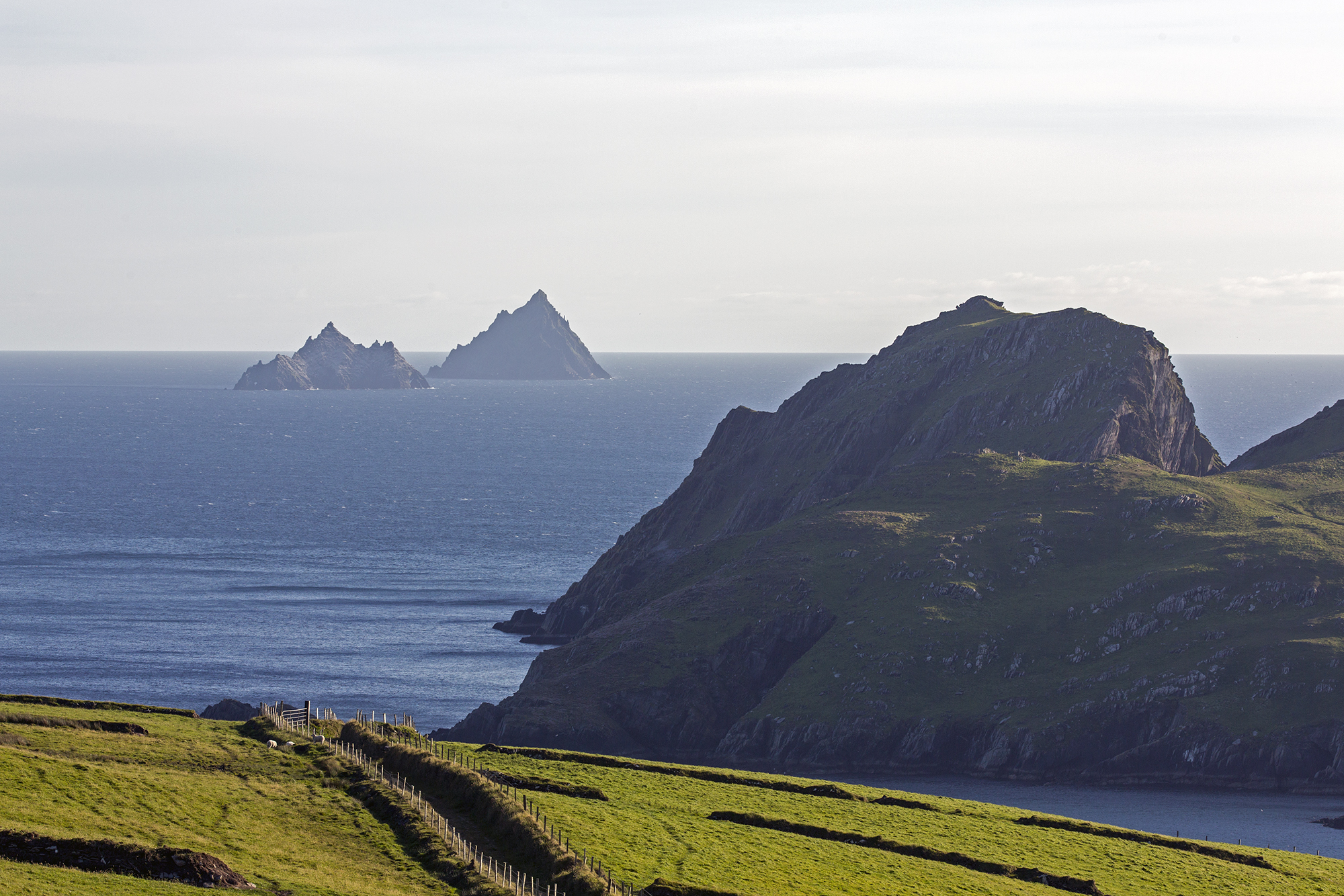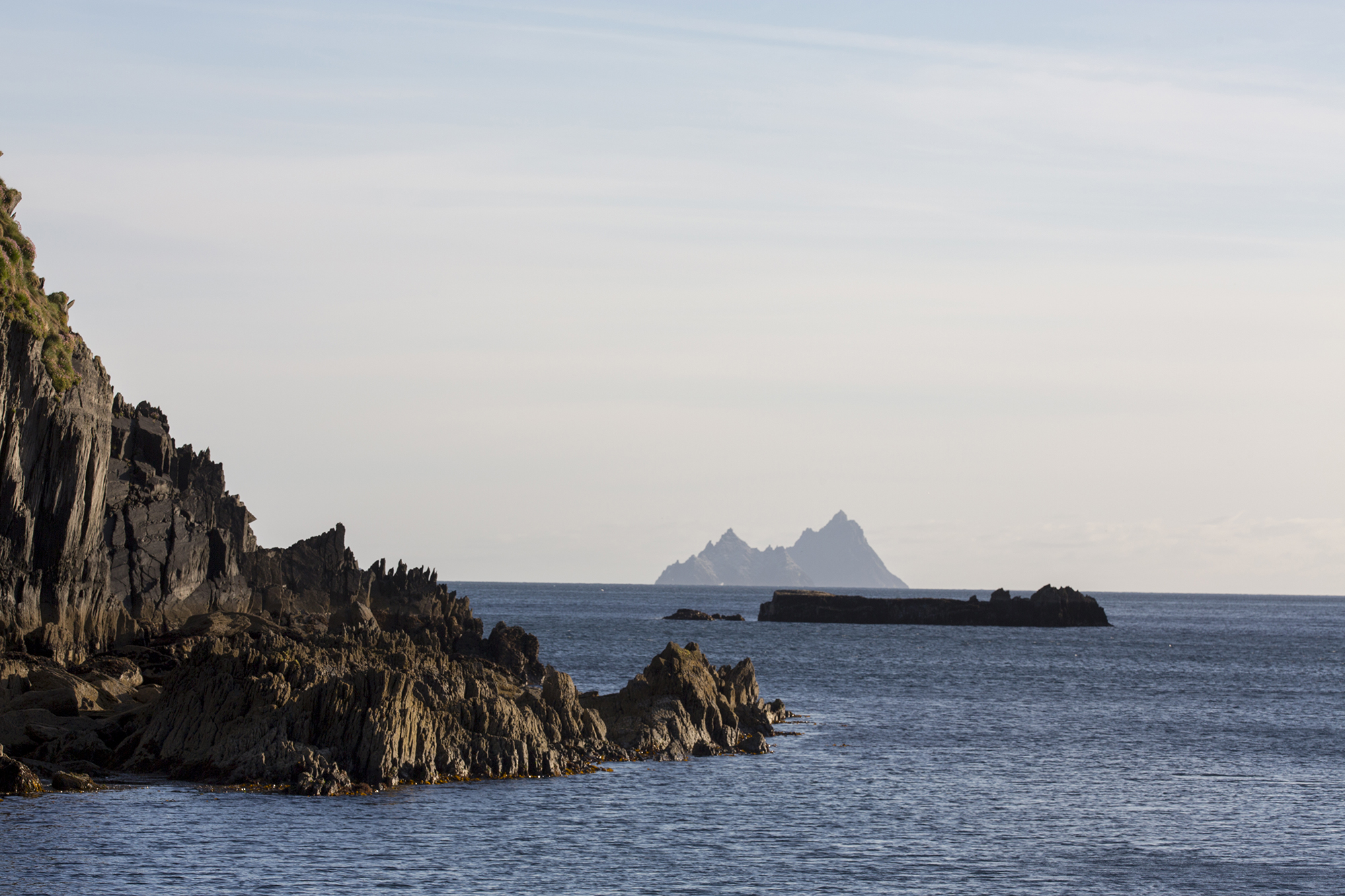The so called ‘disneyfication’ of heritage is a trend that I have often come across as a heritage student. It is not hard to grasp what it means, as the word ‘Disney’ gives away the purpose of this practice. It consists in repackaging a cultural site in a way that resembles the consumerist, happy go lucky, experience based features, which are typical of a Disney theme park. This is usually done with the scope of attracting more tourists to a given place, and to make sure that they spend as much money as possible there.
At Skellig Michael, a small island off the coast of Kerry in the West of the Republic of Ireland, disneyfication was taken to a different level altogether when the island was chosen to be featured in the two most recent films of the Star Wars saga. The Star Wars franchise, for those that might not know is now owned by Disney.
But let’s start from the beginning… In a ‘galaxy’ not so far away…

( View of Skellig Michael- Photograph by Feargal Norton)
Skellig Michael (Sceilg Mhichíl, in Irish) is a tiny rocky island that looks like a dark fin, and surfaces out of the Atlantic Ocean, some 12 km off the coast of the Iveragh peninsula in Co.Kerry. The island was populated starting around the 6th century AD by monks that slowly built a monastery there. The settlement consists of a series of beehive huts, which make up the monastery, the church, and the hermit hut; all accessible through a steep staircase and linked by paths. All these features were built using the only material available on the island- stone slabs. Skellig Michael was chosen to become the site of the monastery because of its isolated nature, and its unique geographical location, which made it the Westernmost Christian religious site of the known world. The small community of monks who populated the island lived there until the 12th century AD, and led a very ascetic and harsh life. After the monks abandoned Skellig Michael, the island was colonised by many species of birds such as the puffin, which made the place into their breading oasis, and these birds remain the only inhabitants of the island.
The unique history and architecture of Skellig Michael, as well as its importance as a natural reserve, are the reasons why it was inscribed in the UNESCO world heritage list in 1996, becoming the second, and last, site to be given this status in the Republic of Ireland.
So far so good then, a beautiful, quite inaccessible place, becomes a UNESCO site. Due to its hard to reach location, and its frail status it is visited by a limited number of tourists, attracted either by the monastic heritage, or by the cute birds, or by both. But then, at some point in 2014, the place was scouted by the people in charge of finding locations for the ‘resuscitated’ Star Wars franchise’s new movies, and that’s when the troubles began.
As I have tried to explain, the island’s archaeology and ecosystem are very fragile, as well as very relevant from an heritage and naturalistic point of view, but regardless of this, some scenes for two episodes of the movie were allowed to be shot here. The first was The Force Awakens, released in 2015, and the second The Last Jedi, which has recently hit the cinemas in December 2017. In the movies Skellig Michael has become the hiding place of Luke Skywalker, and whilst it only features in the last few scenes of The Force Awakens, it is present in a long sequence of The Last Jedi.
A controversial decision
The whole controversy around the shootings developed, because the then Minister for Heritage Heather Humphreys, decided to allow the filming of the scenes for The Force Awakens. She did this without consulting the Irish heritage statutory bodies, or any of the experts that are in charge of providing advice to the minister, when any action is taken in regard to a national monument. Humphreys also decided to do the same for the natural environment aspect of the island. When the news came out that the crew, and their heavy machinery were allowed on Skellig Michael, and a helicopter supplied by the Irish military was also permitted to hover over the island, as well as the provision of an Irish naval ship, despite the fact that there was quite clear opposition from Ireland’s heritage and natural environment experts. Both categories were quite vocal about their concerns regarding the filming at Skellig, but the minister was adamant that the featuring of Skellig Michael in Star Wars could only be beneficial for Ireland. This is because it would have resulted in an increased number of tourists visiting the area, and therefore in sizable economic growth for the county.
This head to head was picked up by various Irish newspapers. For instance the Irish Examiner had an article titled ‘Star Wars on Skellig Michael: A force for good or evil?’ in which the minister expressed her positive outlook on the filming, and in which she denied having taken the decision in a shady, or dishonest manner. Her opinion was in stark contrast to that of Justin Byrne; a council member of An Taisce, who instead considered the effect that the filming had on the natural environment of the island to be negative in many respects.
In September 2015, when it became apparent that some scenes for The Last Jedi were planned to be shot on Skellig Michael in the Spring of 2016, many heritage workers raised their objections once more. This time they wrote to the minister asking for the filming not to be allowed. Famously as reported by the Irish Times, a group of archaeologists and heritage experts wrote to Humphreys stating how they didn’t object to Star Wars being shot on Skellig on principle, but because the relevant authorities were not involved in the process at all they had to object in this instance. They considered how this could set a problematic precedent, and that in the future other Irish heritage sites could suffer the same fate. Some of the archaeologists that signed the letter, and that were generally very vocal about their disappointment with Humphreys, work for University College Cork. Incidentally as an archaeology graduate from UCC, I know these lecturers quite well, and they are all experts in the archaeology of early medieval Ireland, and they were genuinely concerned for Skellig Michael, especially because they had worked on the island themselves, and had contributed to the study of this precious place from an archaeological perspective. Having studied at UCC in the years when the controversy took place, I have to say that it was very frustrating to witness how they were ignored by the heritage minister, who proceeded to allow the filming once more, without taking into account these passionate experts’ opinions on this matter.
To add insult to injury, after the second period of shooting, the Irish Times reported that Claire O’Halloran- another heritage expert, who worked on Skellig Michael for more than twenty years, had expressed her concerns about how the damage that had been caused by the filming had been quite substantial, but had been downplayed by the authorities!
An uncertain future awaits…

(View of Skellig Michael- Photograph by Feargal Norton)
From my point of view, what it is even more important to point out; is that the damage that has been done by the crew is not even that significant, compared to the damage that could be inflicted, if, as hoped by Humphrey; hordes of tourists impose themselves on Skellig Michael, and the surrounding areas! Of course this is impossible to know before Summer 2018, as the movie in which the island featured most was only released in December 2017, and the island is only accessible throughout the summer months, because of the rough seas that surround it, which had successfully insulated it from the wider world for so long.
What is concerning is that the treatment of Skellig Michael, fits into a wider heritage trend, which sees the consumption of cultural sites, and their transformation into disneyfied locations, as a positive occurrence, rather than the damaging force it is!
When I consider what happened to Skellig Michael after reading the academic article by Cornelius Holtorf*, in which the author considers the damage caused to heritage sites by their widespread consumption, as positive. In fact, he proudly asserts that he has removed parts from different heritage sites, and that there is nothing wrong with this practice. This careless attitude sends a shiver down my neck, and I can’t help but think about the fundamental core of the lessons of my archaeology lecturers… ‘archaeology is a finite resource…when it’s gone it’s gone’. Maybe we should stop thinking about heritage as a tourist trap, and start appreciating it again as a legacy of the past from which we ourselves, as well as future generations can learn from!
*Ref: Holtorf, C. (2006). Can Less Be More? Heritage in the age of terrorism, Public Archaeology, 5(2), 101-109.
– The photographs used in this post are copyright of Feargal Norton. The photographer has personally allowed me to use his pictures for this post.
